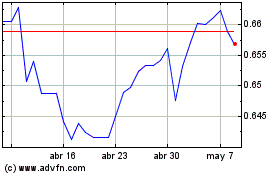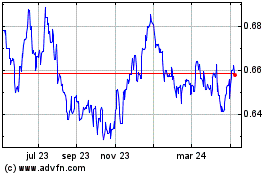U.S. Dollar Advances Amid Risk Aversion
09 Agosto 2018 - 2:10AM
RTTF2
The U.S. dollar climbed against its major counterparts in the
European session on Thursday, as fears over a trade war escalated
after China announced additional import tariffs on U.S. goods,
raising the appeal of safe-haven assets.
China said on Wednesday that it would impose a 25 percent tariff
on $16 billion of U.S. goods, in tit-for-tat move against the Trump
administration's latest import levies on Chinese goods.
Sentiment further eroded after the U.S. said it would impose new
sanctions on Russia over the poisoning of former Russian spy Sergei
Skripal. The sanctions are expected to take effect on or around
August 22.
Meanwhile, Richmond Fed President Thomas Barkin suggested to
raise U.S. interest rates back to normal levels given strong
economic fundamentals.
"It is difficult to argue that lower-than-normal rates are
appropriate when unemployment is low and inflation is effectively
at the Fed's target," he said on Wednesday.
The U.S. weekly jobless claims, wholesale trade and producer
prices are due later in the day, while Chicago Fed President
Charles Evans will participate in a group media interview in
Chicago.
The currency was trading mixed against its major counterparts in
the Asian session. While it fell against the yen and the franc, it
rose against the pound. Against the euro, it held steady.
The greenback advanced to 111.19 against the yen, from a 2-week
low of 110.71 hit at 10:45 pm ET. The greenback is poised to find
resistance around the 113.00 level.
Data from the Bank of Japan showed that Japan's M2 money stock
rose 3.0 percent on year in July, coming in at 1,007.5 trillion
yen.
That was shy of expectations for an increase of 3.1 percent,
which would have been unchanged from the June reading.
The greenback edged up to 0.9951 against the franc, after
declining to a 6-day low of 0.9921 at 5:00 pm ET. Continuation of
the greenback's uptrend is likely to see it challenging resistance
around the 1.01 region.
The greenback reversed from an early low of 1.1619 against the
euro, rising to 1.1576. The next likely resistance for the
greenback is seen around the 1.13 level.
Extending early rally, the greenback hit 0.6641 against the
kiwi, its highest since March 2016. The greenback is seen finding
resistance around the 0.65 area.
The greenback bounced off to 0.7414 against the aussie and
1.3031 against the loonie, from its early 2-week low of 0.7453 and
a 2-day low 1.3000, respectively. On the upside, 0.72 and 1.32 are
possibly seen as the next resistance levels for the greenback
against the aussie and the loonie, respectively.
On the flip side, the greenback dropped to 1.2912 against the
pound, from an early near a 1-year high of 1.2842. Next key support
for the greenback is seen around the 1.30 region.
Looking ahead, at 8:15 am ET, Canada housing starts for July are
set for release.
In the New York session, Canada new housing price index for
June, U.S. weekly jobless claims for the week ended August 4,
producer price index for July and wholesale inventories for June
are due.
AUD vs US Dollar (FX:AUDUSD)
Gráfica de Divisa
De Mar 2024 a Abr 2024

AUD vs US Dollar (FX:AUDUSD)
Gráfica de Divisa
De Abr 2023 a Abr 2024
